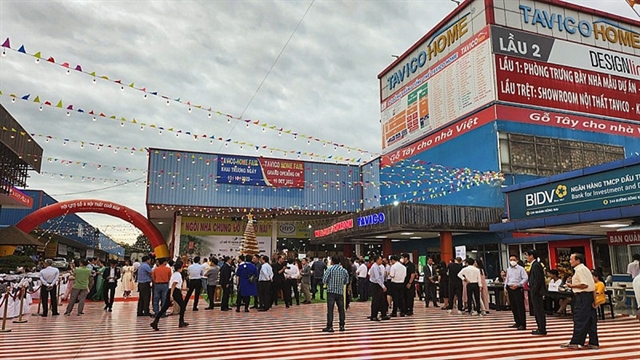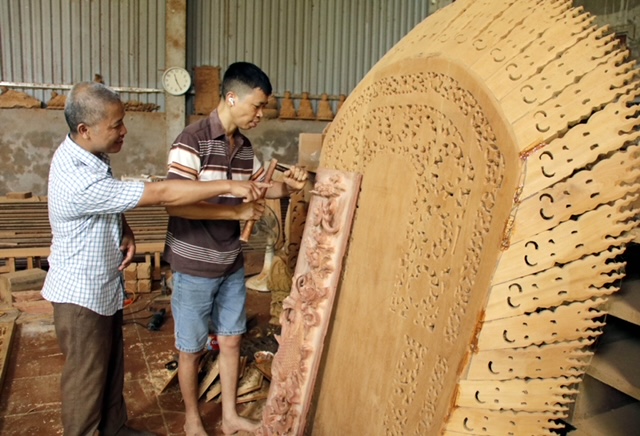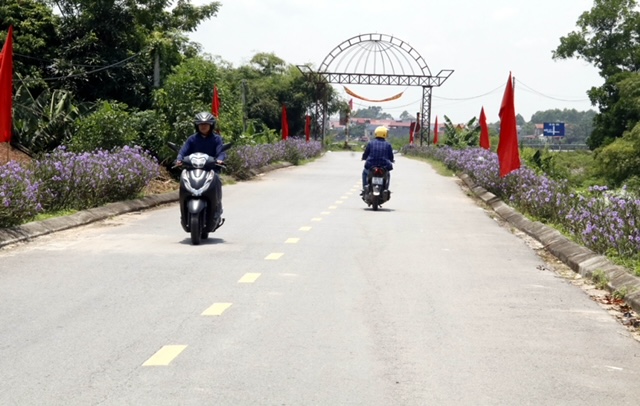 Economy
Economy

 |
| Many households in Xuân Cẩm Commune produce wooden furniture, handicrafts, mechanical goods, and garments, creating hundreds of jobs. |
BẮC GIANG — Settled in the heart of Hiệp Hòa District, Bắc Giang Province, the commune of Xuân Cẩm is an important place in Việt Nam’s revolutionary history.
Recognised as one of 16 Safety Zone or An Toàn Khu (ATK) in Vietnamese, this small commune once played a crucial role in sheltering revolutionary cadres during the resistance wars.
Today, Xuân Cẩm is not only preserving its revolutionary legacy but is also showcasing a remarkable transformation in its journey towards modernisation and rural development.
It is also a commune of resilience, patriotism and deep commitment to Việt Nam's struggle for independence.
In the early 1940s, this commune became a pivotal “red address” for the revolution, hosting key leaders such as Hoàng Quốc Việt, Lê Thanh Nghị, and Nguyễn Trọng Tỉnh, who built and nurtured the revolutionary movement here.
On 12 March 1945, under the leadership of Lê Thanh Nghị and Nguyễn Trọng Tỉnh, the people of Xuân Biều village rose up and seized power, marking the first successful uprising in Bắc Giang Province - a spark that ignited the August Revolution nationwide.
A complete transformation
Deputy Chairman Nguyễn Quang Liêm said this revolutionary spirit has instead fuelled their ongoing efforts to develop the commune, particularly through the new rural development movement.
In 2015, after years of concerted effort, Xuân Cẩm was recognised as a new rural commune, a milestone that laid the foundation for further progress.
Once characterised by narrow, unpaved roads and modest infrastructure, the commune today boasts synchronised development. The main roads in all five of Xuân Cẩm’s villages have been widened, with some now spanning up to 12 metres, greatly improving connectivity and accessibility.
This progress showcases the impact of collective effort and forward-looking leadership in driving meaningful change.
Education is also a priority, with all three of the commune’s schools meeting national standards.
But the transformation is most evident in the economy.
Xuân Cẩm has embraced agricultural innovation, introducing high-yield crops and modern farming techniques.
The establishment of a 30-hectare peach-growing model serving the Tết festival in Cẩm Hoàng village is a standout success, generating over VNĐ1 billion (US$40,000) per hectare annually.
Large-scale field models covering over 200 ha have also been developed across the communes, including the province’s first mechanised rice planting initiative in Cẩm Trung village.
Drones now buzz over the fields, spraying pesticides over more than 30 hectares.
Additionally, Xuân Cẩm Commune has fostered the growth of handicrafts and cottage industries, which provide steady employment for hundreds of local workers. With monthly incomes ranging from VNĐ8 million to VNĐ12 million, these industries have become a cornerstone of the commune’s economic vitality.
One of the most remarkable aspects of Xuân Cẩm’s transformation is the community’s willingness to unite for the greater good.
 |
| Residents of Xuân Cẩm Commune generously donate land to facilitate the expansion of the road |
In a land where the memories of sacrifice are still vivid, over 500 households in the commune have voluntarily dismantled parts of their homes and auxiliary structures, donating over 20,000 square metres of land to expand roads and improve infrastructure.
This generosity has paved the way for development, with the expanded roads now stretching nearly 8km.
The value of the donated land alone exceeds VNĐ300 billion.
These efforts have paid off handsomely. The average income per capita in Xuân Cẩm now stands at VNĐ52.28 million per year, a significant increase over the previous year.
Meanwhile, the commune’s multidimensional poverty rate has dropped to 2.21 per cent, down by 2.13 per cent from the year before.
Preserving cultural heritage
As Xuân Cẩm modernises, it remains deeply connected to its cultural roots, particularly through preserving quan họ folk songs, an integral part of the region’s cultural heritage.
Despite not being a traditional quan họ village, Xuân Cẩm has embraced this art form with enthusiasm, said Nguyễn Quang Liêm, deputy chairman of Xuân Cẩm Commune's People's Committee.
In recent years, the commune has established five quan họ clubs, drawing over 200 members from across its villages.
The initiative has even extended into the local schools, where quan họ youth clubs have been formed, ensuring that this beautiful tradition is passed on to future generations.
Nguyễn Văn Hùng, the head of the quan họ club in Cẩm Xuyên village, recalled how the club began with just 25 members, united by their love for the melodies of quan họ.
Today, the club has grown significantly, thriving on its members' passion and voluntary contributions
The club gathers at the village cultural house every weekend to practise and share their love for quan họ.
The commune regularly organises cultural and artistic festivals, encouraging exchanges between its quan họ clubs and those in neighbouring areas, such as the traditional quan họ villages of Hòa Long Ward in Bắc Ninh City. This cultural exchange enriches the community, ensuring that quan họ remains a vibrant and living tradition.
By 2026, the commune aims to establish five quan họ villages, contributing to the overall number and quality of such villages in Bắc Giang Province, deputy chairman Liêm said.
From its revolutionary past to its modern successes, Xuân Cẩm exemplifies resilience, innovation and cultural preservation, ensuring it remains a harmonious place to live. — VNS